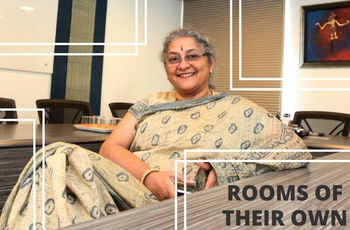Shiny Varghese from The Indian Express speaks with three women architects in the country who set up offices on their own steam, stayed conscious of their values and questioned the very definition of architecture.
Read Full Article:
External Link to The Indian Express page | Abstract (below)
|
Rooms of their own: Three of India’s leading architects on the biases they have overcome The Indian Express | Written by Shiny Varghese | March 5, 2017 We speak to three women architects in the country who set up offices on their own steam, stayed conscious of their values and questioned the very definition of architecture. Histories of women are seldom narrated, much less of those in the design realm, be it Ray Eames who needed a Pat Kirkham to bring her out of her husband Charles’s shadow, or closer home, Urmila Eulie Chowdhury, who worked closely with Le Corbusier in the planning of Chandigarh, but rarely finds a mention in conversations around its making. The male-dominated space of architecture has little room for women to practice the profession without male partners. We speak to three women architects in the country who set up offices on their own steam, stayed conscious of their values and questioned the very definition of architecture. Sheila Sri Prakash, Shilpa Architects, Chennai Is there a difference between “ready-made space” and “space in the making”? Architect Sheila Sri Prakash finds her rhythm in the latter. As a Bharatanatyam artiste, much of her sense of movement and space comes from dance. “Both my dance and architecture are connected. Both involve line and movement. One learns how rhythm can be created and broken, and how boundaries are set. As a dancer, one is always creating a storyline, an ambience for the audience. It’s that space in your head before it’s enacted, where a river flows and the mountain lies,” says 61-year-old Prakash. Her practice, Shilpa Architects, that was launched in 1979, has seen the construction of civic, commercial, residential and industrial buildings across Tamil Nadu, but it didn’t come easy for the award-winning architect. A professor at the School of Architecture and Planning in Chennai asked her at the entry interview if she would be depriving another student; clients told her to design for free because she’s a woman — Prakash battled indifference and scepticism early in her career. But she learnt to balance cynicism with craft. If the Cholamandal Centre for Contemporary Art in Chennai honours artists of the Madras Movement, the Mahindra World City Club draws from the cultural heritage of Kanchipuram. Her response to the materiality of materials is based on its usage. “I love the earthy quality of brick and its porosity, and the transparency of glass. Today, people put a film over glass, place it in the wrong direction, which generates too much heat. We need to ask: why are we placing these windows? Is it only for a view? Or is it for air? Can its proportions change?” At a conference on steel last year, Prakash spoke of its sculptural possibilities. Though she seldom uses it in her own buildings, she asked if the profession could move beyond the industrial use of steel and allow it the movement it affords like in Spanish architect Santiago Calatrava’s Milwaukee Art Museum, where the moveable roof spans out like wings, based on the position of the sun. Prakash’s idea of sustainable design in cities values the role of multiple participants. “It’s like an orchestra, where you include the movement and silences of every member. The reciprocity of design is a value system for urban design indicators which bring holistic sustainability. You can’t design without considering climate, availability of water, human potential and social values,” says Prakash, who has presented this idea of urban design in forums in India and abroad. Yet, Chennai stays close to her heart, even if her army upbringing had her travelling across the country. “I’m from Chennai, and the artistic values I received from the city and my gurus are strong within me. These values are our strength; it’s what differentiates us from the others.” |



